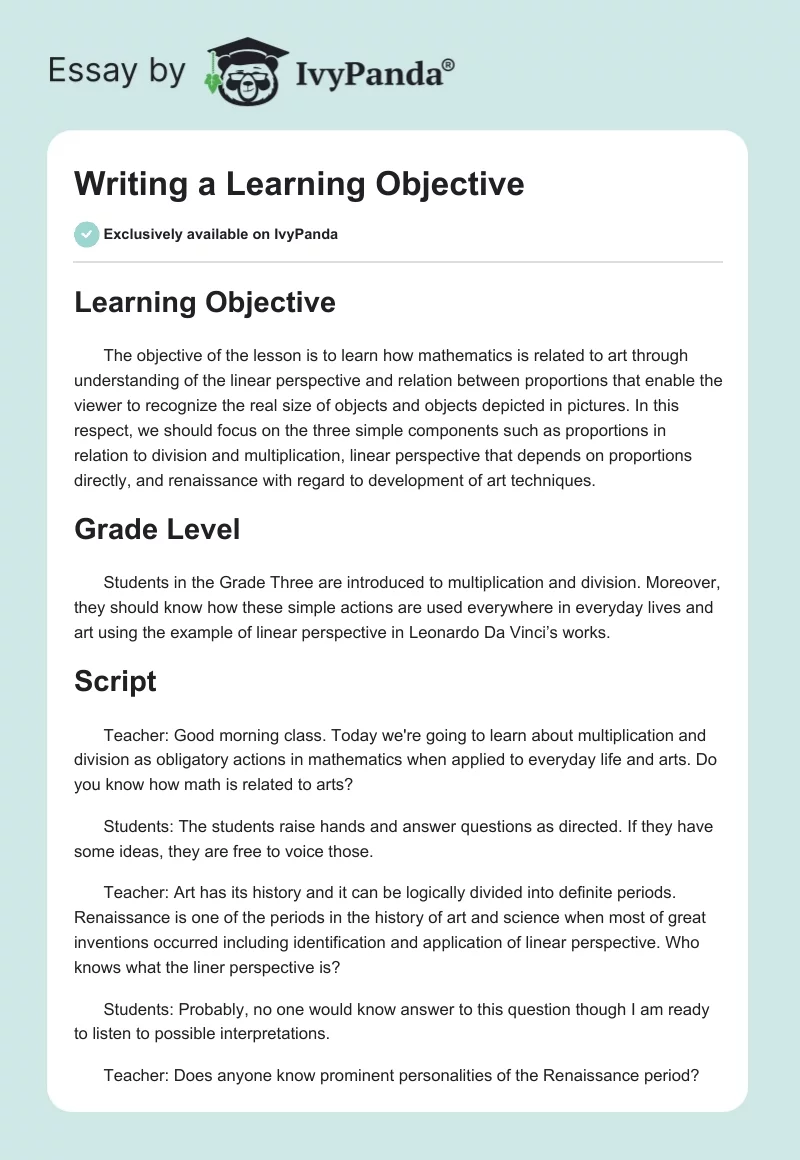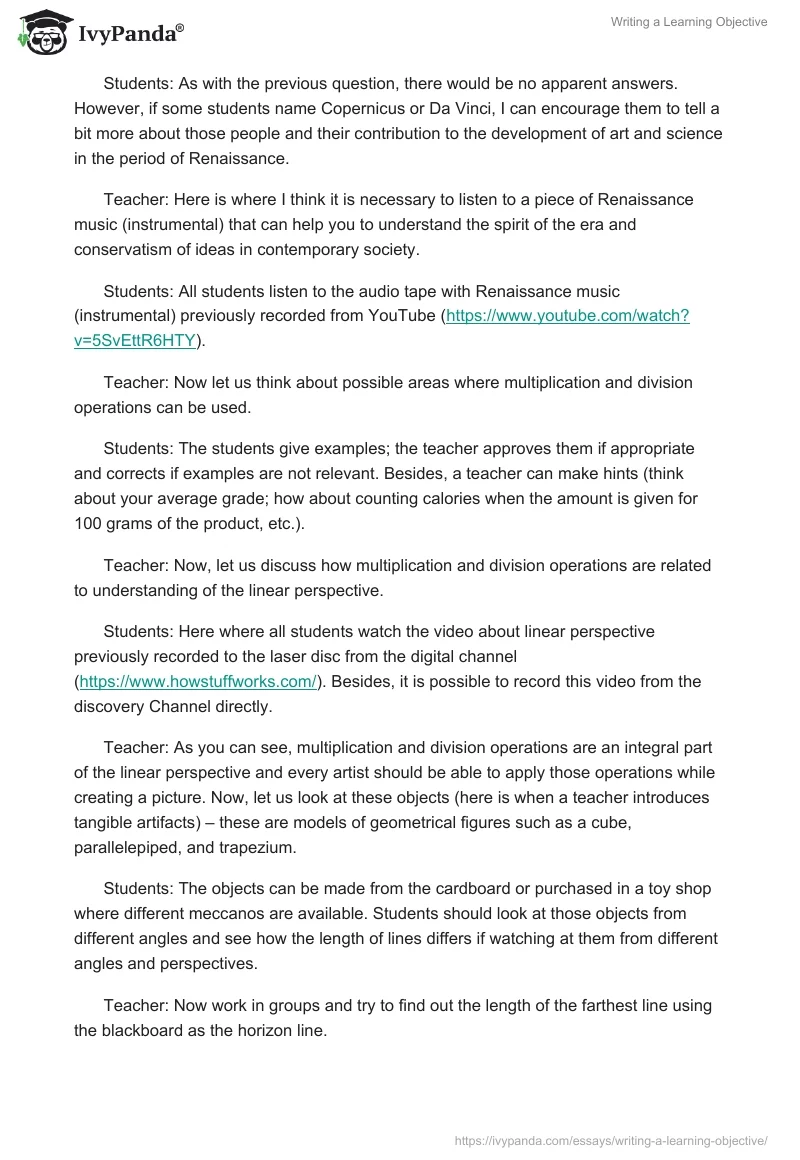Learning Objective
The objective of the lesson is to learn how mathematics is related to art through understanding of the linear perspective and relation between proportions that enable the viewer to recognize the real size of objects and objects depicted in pictures. In this respect, we should focus on the three simple components such as proportions in relation to division and multiplication, linear perspective that depends on proportions directly, and renaissance with regard to development of art techniques.
Grade Level
Students in the Grade Three are introduced to multiplication and division. Moreover, they should know how these simple actions are used everywhere in everyday lives and art using the example of linear perspective in Leonardo Da Vinci’s works.
Script
Teacher: Good morning class. Today we’re going to learn about multiplication and division as obligatory actions in mathematics when applied to everyday life and arts. Do you know how math is related to arts?
Students: The students raise hands and answer questions as directed. If they have some ideas, they are free to voice those.
Teacher: Art has its history and it can be logically divided into definite periods. Renaissance is one of the periods in the history of art and science when most of great inventions occurred including identification and application of linear perspective. Who knows what the liner perspective is?
Students: Probably, no one would know answer to this question though I am ready to listen to possible interpretations.
Teacher: Does anyone know prominent personalities of the Renaissance period?
Students: As with the previous question, there would be no apparent answers. However, if some students name Copernicus or Da Vinci, I can encourage them to tell a bit more about those people and their contribution to the development of art and science in the period of Renaissance.
Teacher: Here is where I think it is necessary to listen to a piece of Renaissance music (instrumental) that can help you to understand the spirit of the era and conservatism of ideas in contemporary society.
Students: All students listen to the audio tape with Renaissance music (instrumental) previously recorded from YouTube.
Teacher: Now let us think about possible areas where multiplication and division operations can be used.
Students: The students give examples; the teacher approves them if appropriate and corrects if examples are not relevant. Besides, a teacher can make hints (think about your average grade; how about counting calories when the amount is given for 100 grams of the product, etc.).
Teacher: Now, let us discuss how multiplication and division operations are related to understanding of the linear perspective.
Students: Here where all students watch the video about linear perspective previously recorded to the laser disc from the digital channel. Besides, it is possible to record this video from the discovery Channel directly.
Teacher: As you can see, multiplication and division operations are an integral part of the linear perspective and every artist should be able to apply those operations while creating a picture. Now, let us look at these objects (here is when a teacher introduces tangible artifacts) – these are models of geometrical figures such as a cube, parallelepiped, and trapezium.
Students: The objects can be made from the cardboard or purchased in a toy shop where different meccanos are available. Students should look at those objects from different angles and see how the length of lines differs if watching at them from different angles and perspectives.
Teacher: Now work in groups and try to find out the length of the farthest line using the blackboard as the horizon line.
Students: The students work in groups and make their assumptions when teacher addresses each group and discuss the objects with the teacher.
Teacher: Now, let us look at the following picture (the teacher introduces a picture Annunciation by Leonardo Da Vinci) and see how lines tend to one point in the horizon line. Here, the teacher addresses students and asks them to show the lines they see and possible point where they tend to join up. This assignment can be also designed by dividing students in groups and giving every group a different picture.
Students: The students are supposed to show the lines in the picture that outline the scheme of the linear perspective approach. The picture can be taken from the private collection of postcards with well-know paintings or borrowed from the library where books on arts are available.
Teacher: To summarize, let us look at the following book and at the page 62 particularly (here the teacher shows the book Eyewitness Art: Perspective by Alison Cole that can be either borrowed from the library or purchased through Amazon.com digital resource in advance).
Students: Students are supposed to indicate that they see linear perspective applied in practice and recognize the horizon line and how the entire scheme of lines changes regarding the position of the viewer toward this horizon line.
Teacher: To conclude, let us write a short description of what we learnt and what we now know about the relation between Maths and painting. Write 150 to 200 words about proportion, linear perspective, and fine arts.
References
Cole, A. (1992). Eyewitness art: Perspective. New York: Dorling Kindersley Publishing, in association with National Gallery Publications, London. Borrowed from library.
Da Vinci, L. (1475–1480) Annunciation. Postcard from private collection.
Discovery Channel. (2011). Assignment Discovery: Blueprint Proportions. Video recording – DVD. Private collection.
Geometrical figures. (2011). Cube, parallelepiped, and trapezium made of cardboard. Private collection.
Theatrum Instrumentorum. (2011). Renaissance music (instrumental). Audio recording – CD. Private collection.


